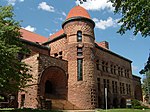Arvonne Fraser Library

Arvonne Fraser Library (formerly the Southeast Library) is a public library in Minneapolis, serving the University community. Designed by Ralph Rapson and built in 1963, the library is an example of brutalist architecture. The building originally housed a credit union for state and university employees before a 1967 repurposing, when it became the Southeast Library. Following a subsequent renovation from 2018 to 2020, the library was renamed after Arvonne Fraser, a women's rights advocate and political campaigner. The library was preceded by several related historical libraries, which occupied other sites throughout the area. These included branches established under the leadership of Gratia Countryman, chief librarian of the Minneapolis Public Library from 1904 to 1936.
Excerpt from the Wikipedia article Arvonne Fraser Library (License: CC BY-SA 3.0, Authors, Images).Arvonne Fraser Library
Southeast 4th Street, Minneapolis
Geographical coordinates (GPS) Address Website Nearby Places Show on map
Geographical coordinates (GPS)
| Latitude | Longitude |
|---|---|
| N 44.980833333333 ° | E -93.237777777778 ° |
Address
Arvonne Fraser Library
Southeast 4th Street 1222
55414 Minneapolis
Minnesota, United States
Open on Google Maps








